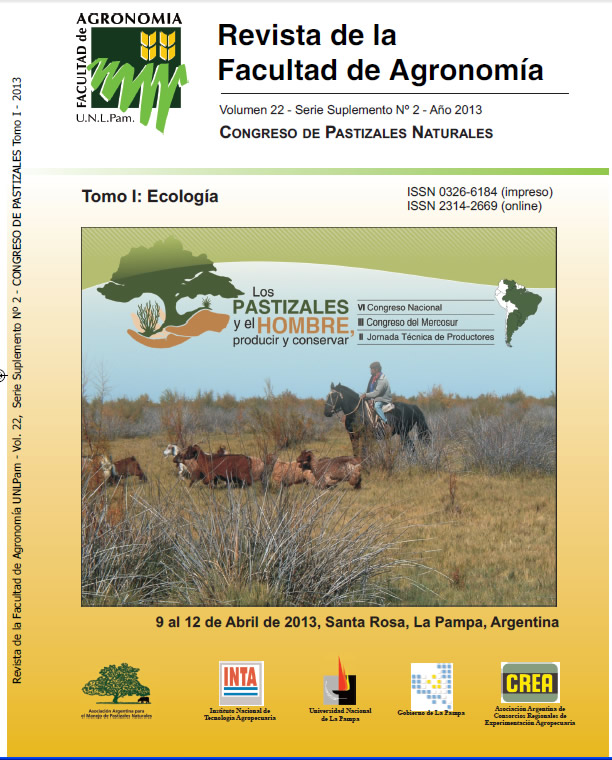Displacement and energy expenditure prediction of sheep managed with different grazing methods and herbage allowances in natural grassland
Keywords:
Continuous stocking, GPS, pampa Biome, rotational stocking,Abstract
The Trial was conducted at an 8.4ha natural grassland area, subdivided into 12 experimental units of 0.7 each in the Universidade Federal do Rio Grande do Sul, when were tested two grazing methods (continuous and rotational(CS and RS) and two herbage allowances (HA; 12 and 18 kg dry matter/100 kg live weight; 12 and 18%), resulting in four treatments: CS12, CS18, RS12 and RS18. The displacement was measured during a 24h period using GPS devices fixed on the ewes back. Together with this evaluation was made a grazing behavior evaluation to synchronize the displacement with the grazing activity. With the GPS data (total and grazing displacement) the energy expenditure was predicted using equations reported in the literature. The herbage allowance did not influence the displacement and the estimations of energy expenditure. The CS presented a higher displacement than RS. Under the assumptions of estimations of energy expenditure, a higher level along all day and during grazing would be expected in the CS. Depending of the pasture quality, variations in the grazing methods could become an important management tool.Downloads
References
Agricultural Research Council (ARC). 1980. The nutrient requirements of ruminant livestock. Technical Review by an Agricultural Research Council Working Party, London. pp. 351.
Cannas A., L.O. Tedeschi, D.G. Fox, A.N. Pell & P.J. Van Soest. 2004. A mechanistic model for predicting the nutrient requirements and feed values for sheep. J. Anim. Sci. 82: 149-169.
Carvalho P.C.F., J.K. Trindade, J.C. Mezzalira, C.H.E.C, Poli, C. Nabinger, T.C.M. Genro & H.L. Gonda. 2009. Do bocado ao pastoreio de precisão: compreendendo a interface planta-animal para explorar a multi-muncionalidade das pastagens. Rev. Bras. Zootec. 38(Supl): 109-122.
Hodgson J. 1982. Ingestive behaviour. In: Herbage intake handbook (J.D. Leaver Ed.). Wallingford: British Grassland Society. pp.113-138.
Kohmann C., Z.M.S. Castilhos, J.M.O. Freitas; A.M.B. Hervé; H.P.F. Soares, C.R. Dillenburg & V.P.S. Silva. 1985. Estudo estatístico de um método de avaliação visual de pastagens comparando ao de cortes. Porto Alegre Secretaria da Agricultura/RS, Anu. Téc. IPZFO. 12: 141- 172.
Downloads
Published
Issue
Section
License
La Editorial de la Universidad Nacional de La Pampa (EdUNLPam) exigirá a los/as autores/as la firma del siguiente documento:
La EdUNLPam lleva a cabo la publicación del artículo: (Título del Artículo) en SEMIÁRIDA Rev.Fac.Agron UNLPam ISSN 2362-4337 (impresa) ISSN 2408-4077 (en línea), del cual el/los abajo firmantes son autores de una o más partes. En el mismo acto, el/los autores entregan exclusivamente a la EdUNLPam todos sus derechos protegidos por las leyes de propiedad intelectual que rigen en la Argentina para reproducir, publicar, editar, fijar, comunicar y transmitir públicamente en cualquier formato o medio impreso o electrónico, inclusive internet, el artículo enviado a publicación e incluirlo en índices o bases de datos nacionales e internacionales. A cambio, la EdUNLPam entrega a los autores la autorización para la publicación o reimpresión con ines académicos y educativos en cualquier libro o medio de divulgación, con la sola obligación de citar el artículo original publicado en la EdUNLPam. Cada autor acuerda en que el material provisto a la EdUNLPam es un trabajo original, que no ha sido impreso o publicado en cualquier otro medio con anterioridad y que no vulnera derechos de terceros. El Primer autor tendrá la posibilidad de leer y corregir el artículo ya editado como “prueba de galera”, pero si el autor no devolviera esas correcciones de la prueba de galera dentro del tiempo especificado, el proceso de producción y publicación podrá proseguir sin la aprobación del autor. El/los autor/es no recibirán compensación monetaria de la EdUNLPam por el uso del material contenido en este artículo y asumen la responsabilidad de las opiniones vertidas en él.






.png)



22.png)



.jpg)




.jpg)
